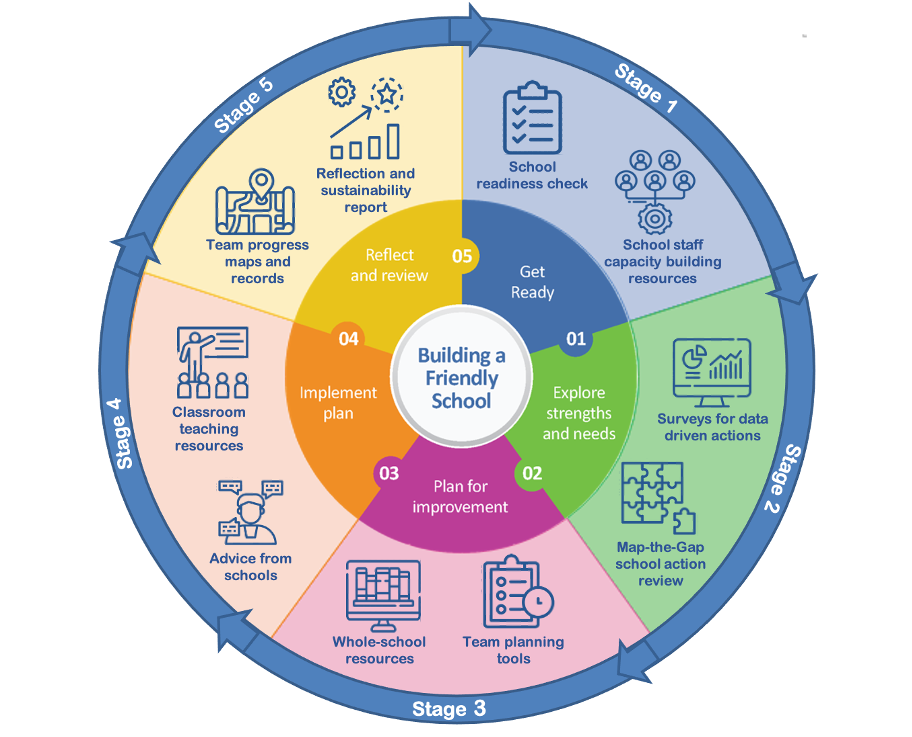Welcome!
Implementing Friendly Schools effectively is an important key to enhancing social and emotional learning while reducing and prevention bullying in your school community. The Friendly Schools Team Guide will help support this.
Designed specifically for school Wellbeing Teams, this online guide breaks down the Friendly Schools implementation process into easy-to-follow steps. By using this guide, your school wellbeing team can stay on track towards achieving your goals by defining and monitoring what needs to be done. The guide also directs your team to tools and links to support each step at the time you need them.
A Whole-school approach
The Friendly Schools research identified evidence-based key elements for practice for schools to increase social and emotional wellbeing and reduce bullying. These key elements have been organised into a framework of eight whole-school components including school connectedness & climate, physical and social environment, classroom teaching and practice, student voice, behaviour and wellbeing support, and family partnerships.
By identifying your current strengths and needs within this framework your school can strategically build capacity to address any gaps, using widely tested strategies. These strategies are supported with a variety of other resources including school case studies, newsletter items, student leadership activities and many other ideas from schools in our research that implement an effective whole-school approach.
Five-stage implementation process
Implementation is a process, not an event and should be seen as a series of stages with small steps towards improvement.
Friendly Schools uses a five-stage implementation process designed to support school coordinating teams in implementing this whole-school approach. It follows a quality improvement cycle, linking all the stages of implementation to support systematic change.
Each stage is broken down into step-by-step actions to:
- Build readiness and understanding for successful implementation.
- Explore your current practice, strengths and needs, against the key elements for practice.
- Identify and plan your recommended strategies for improvement from the evidence.
- Strengthen capacity of staff to implement your improvement plan.
- Reflect and review your actions and implementation process for each cycle of improvement.
Each cycle of implementation is seen as an ongoing process of improvement with each cycle taking schools on average 1 year to 18 months to complete. The cycles continue as the school continues to address the eight components of the framework of whole-school key element to enhance social and emotional wellbeing. Schools work at their own pace to address their needs, with this process typically taking schools three – five years to full implementation.


Available in ‘Evidence for Practice’ handbook, Section 3 or in Schools Login – Team Guide
Available in Primary and Secondary Resources below
Available in Primary and Secondary Resources below
Available in ‘Evidence for Practice’ handbook, Section 3 or in Schools Login – Team Guide
Available in ‘Evidence for Practice’ handbook, Section 2 or in Schools Login Library
Available in ‘Evidence for Practice’ handbook, Section 2 or in Schools Login Team Guide
Available in Primary and Secondary Resources below
Available in ‘Evidence for Practice’ handbook, Section 3 or in Schools Login – Team Guide
Available in ‘Evidence for Practice’ handbook, Section 3 or in Schools Login – Team Guide
Tools for support
Friendly Schools provides all the tools you need to implement your plan for improvement. At each stage of implementation this guide leads your team to valuable resources such as, data gathering tools, practice review tools, staff capacity building resources, advice from schools and other resources to support your actions. These tools provide you with the advice and information you need to make informed decisions about how to implement the Friendly Schools initiative in your school.
Planning and tracking
Furthermore, the step-by-step process of the guide highlights when Friendly Schools supports, such as surveys, review tools, training and other online resources, should be engaged. This ensures that your team has access to all the resources and supports they need to effectively implement the initiative.
Using this guide also provides evidence of the work your team has undertaken. This means that leaders and new staff joining the team can easily see your plan of action and track progress made.
Using the Friendly Team Guide
The Friendly Schools Team Guide has been developed as a learning management system to lead your school Wellbeing Team through the five-stage cycle of implementation in a systematic, step-by-step process. Most schools take a year to 18 months to complete one cycle of action, then they review their progress and plan for their next cycle of implementation.
The guide is designed to be worked through sequentially, however, if your school has already begun this cycle of implementation, it is also possible to check off what you have done and move directly to the stage and steps you are up to within the system.
All team members should access and use the Team Guide, but it is beneficial to nominate a coordinator to be the central point of contact and primary facilitator of the process and the system.
